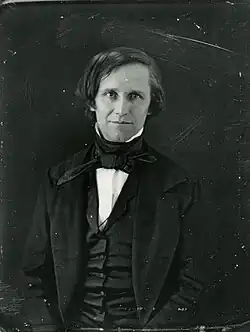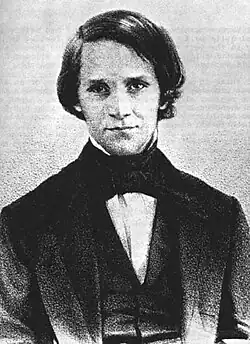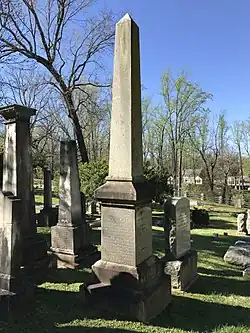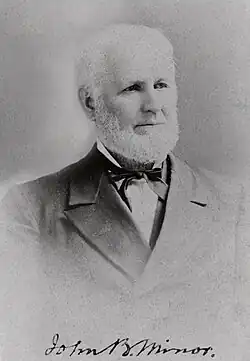John B. Minor
John Barbee Minor | |
|---|---|
 Photograph of Minor, 1859 | |
| Born | June 2, 1813 |
| Died | July 29, 1895 (aged 82) |
| Education | Kenyon College |
| Alma mater | University of Virginia |
| Occupation(s) | Attorney, Law professor |
| Spouse | Martha Macon Davis |
| Children | 3 |
| Parent(s) | Launcelot Minor Mary Overton Tompkins |
John Barbee Minor (June 2, 1813 – July 29, 1895) was an American jurist and professor of law. He practiced law in Virginia before teaching at the University of Virginia School of Law from 1845 to 1895.[1] One source stated, "he has exerted, and still indirectly exerts, a wider influence for good upon society in the United States than any man who has lived in this generation."[2]
Early years
John Barbee Minor was born in Louisa County, Virginia,on June 2, 1813, to Launcelot Minor and Mary Overton Tompkins.[3] Although he was considered frail at sixteen, he undertook the strenuous journey on horseback across Virginia as a newspaper agent and collector, then walked to Ohio to enroll at Kenyon College. After completing his studies there, he walked through Ohio and New York for both health and recreation. In January 1831, he returned to Virginia and enrolled at the University of Virginia, where he studied for three sessions, graduated in several schools, and earned his Bachelor of Law degree in 1834 at the age of twenty-one.
During his time at the University of Virginia he married Martha Macon Davis, sister of his law instructor Professor John A. G. Davis, and served as a tutor in the Davis household.[4][5][6] He was later noted for developing an impressive stature and presence.[2]
Minor was related to the Berkeley, Maury, Dabney, Herndon, Byrd, and Page families and maintained a close friendship and correspondence with Matthew Fontaine Maury and his kinsman B. Franklin “Frank” Minor. Maury Hall and Dabney Hall stand near Minor Hall, a building named in his honor at the University of Virginia.[2]
Career

Minor began practicing law in Buchanan, in Botetourt County. After six years, he moved to Charlottesville, Virginia, where he formed a partnership with his brother Lucian, who later became a professor of law at the College of William and Mary. In 1845, at the age of thirty-two, Minor was elected professor of law at the University of Virginia, succeeding H. St. George Tucker. He remained the sole instructor in the department until 1851.[7] Upon the appointment of James Philemon Holcombe as adjunct professor of constitutional, international, mercantile law, and equity, Minor’s subjects became common and statutory law, in both of which he was considered an authority.[2]

During the sectional debates preceding the American Civil War, he supported the Union, but after the war began, he supported the Confederate government. Minor served as a guard and attendant at the military hospital in Louisa Court House at the University.[8]
As a teacher, Minor took a personal interest in his students, aiming to develop their character as well as their intellect. He influenced James Clark McReynolds, who later served as Attorney General of the United States and as a Justice of the United States Supreme Court.[9] Future U.S. President Woodrow Wilson studied law under Minor in 1879.[10]
Contributions to law


Senator Daniel characterized the Institutes of Common and Statute Law as an unsurpassed vade mecum of legal knowledge. He described the work as solid, compact, and clearly defined, comparable to a statue in form. According to Daniel, it contained a greater concentration of legal principles in fewer words than any other work with which he was acquainted."[2] The first and second volumes of the Institutes of Common and Statute Law were published in 1875, followed by the fourth in 1878. The third volume, long circulated in pamphlet form among Minor’s students, was not issued in complete form until 1895. In 1870, Minor inaugurated a summer course of law lectures, regarded as the first summer law school in the United States. The program gained wide popularity, enrolling over one hundred students.[2]
In addition to his Institutes, Minor published The Virginia Reports, 1799–1800 in 1850, and in 1894 issued the Exposition of the Law of Crimes and Punishments, a work that remained in general use for many years.[7]
Honors
Minor received the honorary degree of Doctor of Laws from both Washington and Lee and from Columbia. On the fiftieth anniversary of his teaching career, the Law Alumni of the University honored Minor with a life-size marble bust. The bust was placed on a polished pedestal inscribed with the words: “He taught the law and the reason thereof.”[2] James Russell Lowell wrote his obituary, noting Minor had signed more law diplomas than anyone in the country's history. Minor Hall, which housed the law school from 1911 to 1932, was named in his honor. The University of Virginia School of Law also established the John B. Minor Professorship in Law and History.
Works
- Minor, John B. A Synopsis of the Law of Crimes and Punishments in Virginia: For the Use of the Students of Law in the University of Virginia. Richmond, Va: M.W. Hazlewood, 1869.
- Minor, John B. Synopsis of the Practice of the Law in Virginia in Civil Cases. Charlottesville, Va., 1874.
- Minor, John B. Institutes of Common and Statute Law. Third edition. Richmond: Printed for the author, 1882. 2 v.
- Minor, John B. Part of the Law of Personal Property: Including the Law of Bankruptcy and the Law of Executors & Administrations. 1888.
- Minor, John B. Synopsis of the Law of Crimes and Punishments. 1890.
- Minor, John B. Exposition of the Law of Crimes and Punishments. Richmond: The author, 1894.
- Minor, John B, and Raleigh C. Minor. University of Virginia: Private Summer Course of Law Lectures, 1895 : Lectures to Commence June 27th, (4th Thursday), and to Continue Two Months. Charlottesville, Va.: 1895.
References
- ^ Iverson, Ian. "John B. Minor & the Tensions of Mastery". Jefferson’s University—Early Life Project, 1819-1870 (JUEL). University of Virginia. Retrieved 17 October 2020.
- ^ a b c d e f g Barringer, Paul Brandon; Garnett, James Mercer; Page, Rosewell (1904). University of Virginia: Its History, Influence, Equipment and Characteristics, with Biographical Sketches and Portraits of Founders, Benefactors, Officers and Alumni. New York: Lewis. p. 356. Retrieved 5 June 2023.
- ^ Genealogies of Virginia Families From the William and Mary College Quarterly Historical Magazine. Genealogical Publishing Com. 1982. ISBN 9780806309552.
- ^ "John B. Minor Family Tree". Our Family Tree. Retrieved 30 December 2016.
- ^ "The Papers of John B. Minor 1845–1893". Arthur J. Morris Law Library Special Collections. Retrieved 30 December 2016.
- ^ Genealogies of Virginia Families From the William and Mary College Quarterly Historical Magazine, Volume 31. Genealogical Publishing Com. 1982. ISBN 9780806309552. Retrieved 30 December 2016.
- ^ a b Lamb, James C. John B. Minor, The Virginia Law Register, Volume 1 (November 1895).
- ^ Gayle M. Schulman. Slaves at the University of Virginia Archived 2012-07-06 at the Wayback Machine.
- ^ Hall, Kermit L. (2005). "McReynolds, James Clark". The Oxford Companion to the Supreme Court of the United States. Encyclopedia.com. Retrieved March 20, 2012.
- ^ Adams, Herbert B. Thomas Jefferson and the University of Virginia: With Authorized Sketches of Hampden-Sidney, Randolph-Macon, Emory-Henry, Roanoke, and Richmond Colleges, Washington and Lee University, and Virginia Military Institute. Washington: Government Printing Office, 1888, p. 119.
Further reading
- Barringer, Paul Brandon; James Mercer Garnett; Rosewell Page (1904). University of Virginia: Its History, Influence, Equipment and Characteristics with Biographical Sketches and Portraits of Founders, Benefactors, Officers and Alumni. New York, New York: Lewis Publishing Company.
- Hitchcock, Susan Tyler (1999). The University of Virginia: A Pictorial History. Charlottesville, Virginia: University of Virginia Press. p. 256 pages. ISBN 0-8139-1902-9.
- Minor, John B. (1923). The Minor Family of Virginia. Lynchburg, Virginia: J.P. Bell Company, Inc.
External links
- John Barbee Minor, 1845-1895, The University of Virginia School of Law
- Virginia Teaching: Early Law Professors, The University of Virginia School of Law
- A Guide to the Law lectures of John B. Minor, 1850 circa, A Collection in the Library of Virginia
- The Papers of John B. Minor, 1845-1893, The University of Virginia School of Law